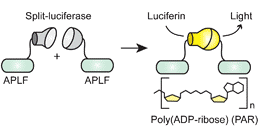Department of Chemistry
ORCID IDs
Document Type
Article
Date of this Version
2011
Abstract
Recent efforts have identified the p38α Ser/Thr kinase as a potential target for the treatment of inflammatory diseases as well as non-small cell lung carcinoma. Despite the significance of p38α, no direct activity probe compatible with cell lysate analysis exists. Instead, proxies for kinase activation, such as phosphospecific antibodies, which do not distinguish between p38 isoforms, are often used. Our laboratory has recently developed a sulfonamido-oxine (Sox) fluorophore that undergoes a significant increase in fluorescence in response to phosphorylation at a proximal residue, allowing for real-time activity measurements. Herein we report the rational design of a p38α-selective chemosensor using this approach. We have validated the selectivity of this sensor using specific inhibitors and immunodepletions and show that p38α activity can be monitored in crude lysates from a variety of cell lines, allowing for the potential use of this sensor in both clinical and basic science research applications.


Comments
Published in ACS Chemical Biology 6:1 (2011), pp 101–105; doi: 10.1021/cb100230y Copyright © 2010 American Chemical Society. Used by permission.